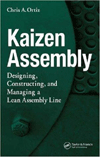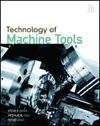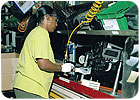
People continue to be found on assembly lines today because humans are still the most programmable, efficient "machines" for most assembly tasks.
Ever since machines first began to alter the manufacturing landscape in the mid-19th century, humans have had a love-hate relationship with the devices. On one hand, steam engines, electric motors, conveyors, automated looms and machine tools made factory life easier, safer and more productive. But, on the other hand, they also took away some of the human element.
During the early 20th century, the dawn of the Machine Age led to a dramatic division of labor. Craftsmen who understood the entire production process were quickly replaced by specialists who focused on just a single step of the process.
While machines were often feared by workers, machines were revered by management because they were controllable, efficient and predictable. For many decades, the universal goal in manufacturing was to create a factory that ran like a machine. Most assembly lines were designed around machines; human interaction was merely an afterthought.
In 1936, a popular movie called “Modern Times” illustrated the classic man vs. machine saga. Charlie Chaplin played the role of an assembler who struggles to keep up and eventually becomes enslaved to a dehumanizing machine. In the movie’s most memorable scene, Chaplin is whisked away by a fast-moving conveyor and ends up inside a machine, riding through a maze of huge gears and flywheels.
By the time the term “automation” first appeared in the late 1940s, machines were idolized as the backbone of the American economy. However, human-machine interaction dramatically changed in the 1960s with the advent of computers, numeric controls and robots.
Manufacturers attempted to automate everything and remove the entire human element with lights-out factories. That led to a widespread automation scare and a backlash from organized labor. But, squeezing humans entirely out of the assembly process often proved to be more expensive and more difficult than most people first imagined.
“Ironically, the big fear was that automation was going to put everybody out of work,” says Geoffrey Boothroyd, Ph.D., cofounder of Boothroyd Dewhurst Inc. (Wakefield, RI). “Quite the opposite happened. The restrictions at places like Ford and General Motors, where workers fought the automation experiment, is one of the reasons why those companies are not leading the world market now. Automation is not necessarily the solution at the U.S. automotive companies, but it should have been among the economic strategies selectively applied back then.”
After decades of machine advances, recent lean manufacturing initiatives have once again stressed the importance of the human element. While many manufacturers use a wide variety of robots, conveyors and other types of automation, people remain the most flexible “machine” available for performing numerous assembly tasks, especially when it comes to building airplanes, automobiles, boats, locomotives, printing presses, refrigerators, tractors, trucks and other large, complex products.
Indeed, people continue to be found on assembly lines today, even though the first decade of the 21st century is almost history. “Humans are still the most programmable, efficient machines for most assembly tasks,” proclaims Boothroyd.
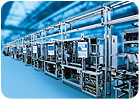
After years of talk, lights-out automation remains elusive to most assemblers.
Lights-Out Automation
Lights-out factories have long been a dream of manufacturing engineers. The concept refers to a fully automated facility where human hands never touch the product during the entire manufacturing process. In theory, a lights-out plant would operate 24 hours a day, seven days a week, with downtime only for routine maintenance or repair.According to Jim Pinto, an automation consultant based in San Diego, there’s an old joke that probably originated in Japan: “The fully automated factory of the future employs only one man and a dog. The dog is there to make sure the man doesn’t touch anything, and the man is there to feed the dog.”
The lights-out idea is not new. Generations of manufacturing engineers have heard about it and some have tinkered with the concept over the years.
One of the first people to experiment with lights-out automation was Oliver Evans (1755-1819). He was an innovative millwright who created the world’s first continuous production line in 1784. Evans used a variety of wooden shafts and gears, plus leather and canvas belts, to transfer power to a sequence of machines connected to the same waterwheel at a flour mill in Delaware.
Evans’ mill automatically moved wheat from one operation to another using conveyor belts. As a result, the mill could operate with much fewer humans than before. One person was stationed at the beginning of the process, where he poured the grain into a hopper. Another individual was positioned at the other end of the factory, filling sacks with the flour produced by the mill. All the intermediate operations were carried out automatically.
In 1790, Evans received one of the first patents issued in the United States (No. 3) for his automated process, and he eventually became the first American manufacturer of steam engines. Ever since, most lights-out operations have been confined to process industries, such as chemicals, food, pharmaceuticals and textiles.
But, several assembly success stories have emerged over the years. For instance, Lloyd Smith (1882-1944) developed the first fully automated plant in the world in the early 1920s. His factory in Milwaukee could produce one automobile frame every 8 seconds or 10,000 per day. It operated almost nonstop until 1958. A wide variety of high-speed tasks were performed in the plant, including hole punching, riveting and welding.
In the mid-1960s, Polaroid Corp. opened a lights-out assembly plant in Waltham, MA, to produce packs of film that were untouched by human hands. Conveyors routed parts from fabricating machines on the first floor of the factory that made plastic box bottoms, metal box covers and metal pressure plates. The parts were conveyed to automatic assembly machines located on the second floor. The machines assembled the parts and joined them with film and developing materials to form a finished pack. Once assembled, conveyors transferred the packs to automatic packaging machines.
Engineers at IBM Corp. (Armonk, NY) built a lights-out plant in Texas in the 1980s to assemble computer keyboards. They also envisioned building computer printers and other products in a similar fashion. However, the project was short-lived, because the necessary fixed tooling made the plant too inflexible to handle any level of product variation.
Today, lights-out applications are common in the process industries, which tend to be highly regulated. “Batch runs are much longer when you’re processing food or chemicals,” says Manbir Sodhi, a professor of industrial and systems engineering at the University of Rhode Island (Kingston, RI). “Material handling and delivery is simplified. Valves can easily be opened or closed automatically, and temperature can be monitored remotely. It’s also easier to build fail-safe modes in a process industry.
“There’s not much uncertainty in the process industries, because reactions are much more deterministic,” adds Sodhi, who specializes in highly automated manufacturing. “You’re typically cooking or cooling material for a predetermined amount of time. Unit models are used in the process industries, but not in discrete manufacturing.
“On an assembly line, complexity is much, much higher,” Sodhi points out. “Today, multiple variations of a product are usually assembled on the same line, which requires a tremendous amount of flexibility. That’s something difficult to achieve with lights-out automation.”
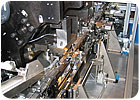
There's more automation in manufacturing today than ever, but it's more targeted and focused than in the past.
An Elusive Myth?
After years of talk, lights-out automation remains elusive to most assemblers. According to Pinto, it’s still a myth in discrete manufacturing. “Lights out was a nice concept, but it has not proven really practical,” he explains. “The truly ‘human eliminating’ technology has simply not come about.”“There are areas where you can’t possibly replace the human being,” adds Boothroyd. “For example, industry has found it impossible to automate the installation of wiring and harnesses. That alone would exclude airplanes and autos from a lights-out approach.”
While there is more automation in American manufacturing today than ever, “it’s more targeted and focused,” says John Dulchinos, president of Adept Technology Inc. (Livermore, CA). “Manufacturers just aren’t automating every process. Competition from China and other low-cost countries today is forcing manufacturers to be more careful in how they deploy capital.”
According to Dulchinos, it’s possible to automate most parts of the assembly process, but that doesn’t mean that full-blown automation is the best approach to take. “Things that have a lot of variability, such as material handling, just don’t always make sense to automate,” he explains. “It makes more sense to provide targeted automation to optimize process steps.”
Of course, some production plants approach near lights-out status, especially in the consumer goods industry where highly automated facilities mass-produce products such as batteries, electric toothbrushes, light bulbs and razors. In the auto industry, most body shops feature highly automated robotic welding and painting lines. But, they are not true lights-out operations, because people are still involved in the process.
“The semiconductor industry has been talking about lights-out factories for more than 10 years, but even the largest and most advanced manufacturers haven’t been able to realize this dream,” says Kurt Greissinger, product marketing manager for manual production systems at Bosch Rexroth Corp. (Buchanan, MI).
“Very few companies have the necessary criteria to meet the requirements of lights-out,” adds Greissinger. “Only factories with high volume, low-to-no mix, and long product life cycles can afford to automate to such an extent. Most of the companies I encounter cannot meet these requirements, due to market needs, diversified manufacturing or technical obsolescence.”
As a result, lights-out applications are typically found only in portions of manufacturing plants today. For instance, some manufacturers have machines that run by themselves during the night molding plastic parts. Then, in the morning, assemblers put them together.
“It’s not necessarily the ideal state,” says Jamie Flinchbaugh, a partner at the Lean Learning Center (Novi, MI). “Lights-out, to some degree, assumes that there will be no problems or that all problems can be solved from a distance. But, if you are not at the point of activity to observe and see, how will you be able to solve the problem? In some factories, the whole physical material transformation is automated, but they still have equipment technicians on the floor. Until you have 100 percent quality and 100 percent uptime, true lights-out is not much of a plan.”
For lights-out automation to work, line speeds need to be very high. “It’s not economically feasible to automate the assembly tasks in complex products,” notes Boothroyd. “The basic requirements for economic automatic assembly are that you’ve got a high-volume product-something that’s produced in the millions-and that the product has a sufficiently long market life. It can take up to 3 years to develop a sophisticated machine, and you then need to run that machine for at least 3 years to recoup your investment.
“Manufacturers don’t want any change in the market during that period,” Boothroyd points out. “You want stability of the design features and functions. Changing market requirements for the product causes a decrease in profits. So, it’s got to be a very stable, high-volume product for automation.”
“In theory, lights-out automation requires a great amount of control over all processing, which can be very expensive up-front,” says Mike Perreault, president of Excel Performance Inc. (Hugo, MN), an automation consulting firm. “In most cases, humans are still more effective, because the operator decision-making process is quite complex.”
“We can move toward replacing the human element in select circumstances,” notes Perreault. “But, a lot of technology still needs to be developed, and additional cost needs to be taken out of automation. Lights-out automation has been overshadowed by lean manufacturing in recent years, but we are much closer to it than we were before.”
“The last time most people talked about lights-out assembly lines was back in the early 1980s,” adds Larry Stockline, president of Promess Inc. (Brighton, MI). “Yet here we are 25 years later, and it’s still ‘just around the corner.’ Economics doesn’t really justify it today, but I think it’s possible; the feasibility is definitely there.”
Recent advances in controls, material handling equipment, robotics, remote diagnostics and sensors make the lights-out dream one step closer to reality. According to Joe Campbell, chief operating officer of Applied Manufacturing Technologies Inc. (Orion, MI), robots have made a quantum leap in the last 5 years.
For instance, there have been many improvements in accuracy, controls, speed, reliability and sensing functions, such as vision and force. At the same time, costs have dropped. Today, robots are smarter and more adaptable to production environments, says Campbell.
One big advancement has been tactile feedback. “For a human, the sense of touch is something we rarely think about,” says Ted Wodoslawsky, vice president of marketing at ABB Robotics (Auburn Hills, MI). “A robot having the ability to sense and react is a new innovation. We call this ability force control.
“Think of something as simple as a person assembling a torque converter into an automatic transmission,” adds Wodoslawsky. “The worker picks up the torque converter and places it on the input shaft. The torque converter must be correctly aligned with the splines on the input shaft before it is pushed onto it. For a person to feel and adjust the position of the torque converter is a relatively easy task-not so for a robot.
“A robot will put anything anywhere you tell it to, including forcing the torque converter on the shaft, regardless if it is lined up correctly or not,” explains Wodoslawsky. “With force control, the robot can now sense based on feedback from sensors-the same way a human can-and act accordingly.”
Several major hurdles still need to be overcome before lights-out automation truly makes sense for more than just a few random assembly applications. For instance, management must believe that a lights-out facility is possible.
“That’s a huge psychological hurdle to overcome,” says John Clark, national sales manager for EPSON Robots (Carson, CA). “It requires a huge leap of faith. The current obstacle is the question facing operations managers: ‘Am I smarter to invest in lights-out automation or move production to a low labor-cost country?’”
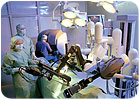
Robots and humans work closely together in surgical applications.
Parts Design Is Important
Another thing that hinders lights-out assembly applications is the fact that many parts are not designed for automation. “In the ideal world, manufacturers would start from the beginning–part design,” says Clark. To achieve lights-out status, engineers need to eliminate components that require manual assembly and make sure that all parts can be easily assembled.“Lack of a viable 3D, bin-picking vision system also hinders lights-out automation,” claims Clark. “Today, large sums of time and money must be spent to ensure that parts are neatly arranged for subsequent operations.”
Even if those challenges can be addressed cost-effectively, scaling up from manual or semiautomated assembly to lights-out automation is very difficult. “Getting the last person out of the process is very, very expensive,” warns Sodhi. Trying to automate the last 10 percent is expensive and complex, because the indirect labor associated with automation, such as programming, maintenance and other support roles, is often underestimated.
Instead of trying to achieve a lights-out operation, many experts believe a better strategy is to focus on continuous improvement or to design products so they are easier to assemble.
“We don’t see more progress in achieving a lights-out factory because it is an abstract goal,” explains Boothroyd. “Production of various discrete subassemblies in a complex product will always need human intervention.
“Designing for easier assembly should always be the first strategy,” claims Boothroyd. “This is true whether your final aim is manual or automated assembly. And in automatic assembly strategies, it’s essential that the products be designed so they’re suitable for the chosen process.
“In products intended for manual assembly, people will sometimes say, ‘Oh, assembly costs aren’t a very big portion of our total costs, so why are we bothering with Design for Assembly?’ The fact is, when you design something that’s easier to assemble, it’s a better overall product with fewer parts and with significant savings in quality, factory throughput and other operational costs.
“The IBM Proprinter was first designed it so it would be easy to assemble by robots,” Boothroyd points out. “Well, the printer was so easy to assemble manually that it took only 3 minutes by hand. Robots were not the right assembly choice in the final analysis.”
Many experts also believe that manufacturers should focus more attention on continuous improvement programs. During the last decade, many lean manufacturing initiatives have helped thousands of companies cut waste and improve efficiency on the plant floor. For instance, the recipient of the 2007 Assembly Plant of the Year Award, Square D/Schneider Electric (Lexington, KY), is more productive today than it was when it opened 50 years ago, despite having less than half as many employees.
“We had well over 1,000 workers at one point in time vs. around 400 employees today,” says Bob Spence, plant manager. “[Because of lean], we are much more efficient now, as we put out more product at 400 employees than we did with over 1,000.”
Contrary to popular belief, lean is not anti-automation. “When automation is more productive or safer it is a good idea,” explains Flinchbaugh. “Lean will help you make the process more efficient and effective, and design-for-assembly will reduce the cost. Both should be done. If lean can be done first, once you apply automation, it will be more effective.”
In many cases, lean principles are contrary to the lights-out approach because they encourage experimentation. “This might mean reconfiguring a workcell by moving people and machines or right-sizing the equipment to meet the task at hand,” notes Greissinger. “This wouldn’t happen by the nature of a lights-out operation. Lean initiatives will certainly pay-off more in terms of manufacturing flexibility.”
“Humans are a lot more flexible than most machines,” adds Dave LaHote, head of lean education at the Lean Enterprise Institute (Cambridge, MA). “They can produce a wide variety of products on an assembly line. Humans can also respond to change much more easily than machines. The ongoing trend toward mass-customization will prevent a push for lights-out assembly lines.”
“Since we cannot get the last person out of the production process, we need to make product manufacturing as foolproof as practicable so the human element exerts little influence on a well-developed process,” says Ed Zimmerman, PE, director of technical operations at Apex Automation Inc. (Elizabethown, PA). “We need to apply technical solutions where technical solutions excel, and apply human solutions where human solutions excel.”
According to Zimmerman, technical solutions are better than humans at 100 percent inspection, high speed and highly repetitive operations, controlled high-force applications, precise positioning, and dirty, dull and dangerous tasks. Humans are better at decision-making with less-than-complete information, interpreting unforeseen feedback, and finesse in the handling of flexible or inconsistent components.
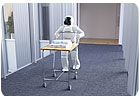
In the future, humanoid robots will perform a wide variety of assembly tasks alongside humans.
Future Interaction
People and machines will continue to interact on tomorrow’s plant floor. In fact, they may eventually work closer together than ever.Traditionally, robots have been confined to enclosed workcells. But, that will soon be a thing of the past.
“Robots and humans are typically separated on the plant floor,” says Sal Spada, research director for discrete automation at ARC Advisory Group Inc. (Dedham, MA). “The goal is to get operators in the work envelope, which would allow robots and humans to work side-by-side.”
The robotics industry is developing safe motion technology to achieve an optimal degree of automation and productivity. Robot vendors have been experimenting with new sensing systems and microprocessors that allow people to work in close proximity to robots without the risk of getting hurt. By eliminating safety fences, safety mats, light curtains and other safeguards, manufacturers will also be able to reduce overall floor space.
“Automotive OEMs have been pushing for this technology,” says Spada. “They see a tremendous productivity gain in workcells where an operator can be within the work envelope to perform setup, changeover and some maintenance operations while the machine remains under control.”
Chris Blanchette, manager of national distribution sales at FANUC Robotics America Inc. (Rochester Hills, MI), predicts that robots will soon become a more common sight on final assembly lines in the auto industry. He foresees a day in the not-too-distant future when humans and robots work in close proximity. They will team up to become colleagues rather than adversaries.
“However, it will take some time for the concept to be accepted,” warns Blanchette. “The technology is out of the lab and we’re currently adding to our existing lineup of robots. So far, we’ve seen a lot of interest in the technology, especially in the auto industry.”
Blanchette says the aerospace industry will also be making a big push to use robots on future assembly lines. “There’s a major initiative underway to use more flexible automation in assembly, such as airframe construction,” he points out.
Adept’s Dulchinos agrees that robots and humans will become more intertwined in the future. “They will work closer together on assembly lines,” he predicts. “We’re already seeing this in the healthcare industry, where robots are used as doctor’s aids during surgical procedures.”
Ultimately, robots will begin acting like humans. In the future, humanoid robots will perform a wide variety of assembly applications alongside human operators. In fact, engineers at Honda Motor Co. (Tokyo) and Toyota Motor Corp. (Nagoya, Japan) have already developed humanoids that can perform basic tasks in a controlled setting.
The next step is to put humanoids on the plant floor. But, before that happens, engineers still need to develop adaptable robots that can learn through experience, which is where humans excel.
Numerous cognitive research projects promise to make this a reality sooner than later. For instance, engineers at several U.S. universities are currently teaching humanoids how to make simple choices and react to human brain waves.
Click "Web Extra" to learn more about the man vs. machine debate. A





